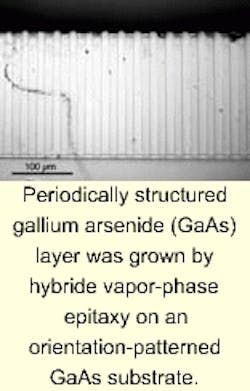New nonlinear materials expand access to the IR
Robert C. Eckardt
Research and development of nonlinear infrared (IR) materials is finally beginning to bear fruit. The result—more IR sources—is expanding access to the spectral region from the mid IR to beyond 10 µm and opening up new applications in the process.
Current nonlinear IR materials—including zinc germanium phosphide, silver gallium selenide, cadmium selenide, and silver gallium sulfide—work for difference frequency generation, second-harmonic generation, and optical parametric oscillators. Yet each also has properties that limit performance in some way. Typical problems include restricted regions of high transmission, an inability to achieve birefringent phase matching at a desired wavelength, and thermal lensing at higher average powers due to low thermal conductivity and residual absorption.
These limitations are driving efforts to fine-tune nonlinear infrared materials. The goals are materials with good optical and thermal characteristics, which are highly transmitting, and can be phase matched over wider spectral ranges.
Material matters
In particular, there is renewed interest in periodically structured zinc-blend materials for nonlinear optical application. This trend has been fueled by the success of periodically poled ferroelectric materials for quasi-phase-matched nonlinear optical applications in the near infrared and visible.
Common ferroelectric materials include lithium niobate, lithium tantalate, and potassium titanyl phosphate (KTP) and its isomorphs. All work well in the visible and near-infrared, but are limited by infrared absorption at wavelengths longer than 3 or 4 µm. Materials such as gallium arsenide, zinc selenide, zinc telluride, and other semiconductors with zinc-blend structure are attractive alternatives.
Highly transmitting over wide spectral regions, these zinc-blend materials have good thermal properties, large nonlinearity, and relatively high thresholds for optical damage. They are not birefringent, though, and therefore require a technique such as quasi-phase matching for efficient nonlinear infrared conversion.
In birefringent phase-matched processes, the nonlinear crystal couples the optical fields of different polarizations. Nonlinear processes, such as harmonic generation or parametric interactions, are phase dependent. For one coherence length, normal dispersion of the material produces a relative phase change that reverses the direction of power flow in the nonlinear frequency conversion process. The resulting non-phase-matched conversion oscillates at low efficiency levels. Material dispersion is compensated for by the different indices of refraction of orthogonal polarizations in birefringent phase matching, allowing constructive growth of the conversion process.
In quasi-phase matching, different coherence lengths add constructively and birefringence is not required. In some cases, such as periodically poled lithium niobate, a larger component of the nonlinear tensor is accessed when all polarizations are the same. Electric field poling is one way to reverse the orientation of adjacent domains in quasi-phase-matched ferroelectric materials. Different techniques are required for the materials with zinc-blend structure.
Quasi-phase matching was first proposed in 1962.1 It was implemented in the 1970s with stacks of air-spaced gallium-arsenide plates in alternating orientations at Brewster's angles.2,3 Even then, the losses of the high-index surfaces limited the number of usable plates to about 20. Useful nonlinear conversion requires approximately one hundred plates, one coherence length in thickness. More would be useful.
Searching for solutions
In related news, research groups at Stanford University (Stanford, CA) and Thomson CSF (Orsay, France) have successfully lowered the absorption losses in periodically structured gallium arsenide. The Stanford group has diffusion-bonded stacks of wafers achieving losses in the range of 0.2% per interface.4 For useful nonlinear IR devices, though, another order of magnitude in loss reduction is required. Thompson CSF has demonstrated that this reduction level is possible at a point where there are near bulk-material loss levels over a small region of a diffusion-bonded stack.5
Of particular interest is the collaborative work of the two groups. In this research, layers of periodically structured gallium arsenide (GaAs) several hundred microns thick were grown by hybrid vapor-phase epitaxy on orientation-patterned GaAs substrates.6 The substrate was prepared with a process employing molecular beam epitaxy (MBE) of an inverted GaAs layer, lithographic patterning, wet-chemical etching, and MBE regrowth.
Direct growth of periodically structured material has the potential to provide the low losses essential for high performance. Other growth techniques have been considered, but the precise control of structure has been elusive. Recent progress is encouraging, though.
Ultimately, high-quality periodically structured nonlinear infrared materials could replace the bulk materials currently in use. With this step would come a wide range of new applications, including coherent spectroscopy and ellipsometry at lower power levels and the driving and controlling processes at higher power levels.
REFERENCES
- J. A. Armstrong et al., Phys. Rev. 127, 1918 (1962).
- A. Szilagyi, A. Hordvik, and H. Schlossberg, J. Appl. Phys. 47, 2025 (1976).
- D. E. Thompson, J. D. McMullen, and D.B. Anderson, Appl. Phys. Lett. 29, 113 (1976).
- D. Zheng et al., Opt. Lett. 23, 1010 (1998).
- E. Lallier, M. Brevignon, and J. Lehoux, Opt. Lett. 23, 1511 (1998).
- L. A. Eyres et al., OSA Tech. Digest, CLEO 2000 paper CFN3, Optical Society of America, Washington, D.C., 630 (2000).
Robert C. Eckardt is a senior staff scientist at Cleveland Crystals Inc., Highland Heights, OH 44143; e-mail [email protected].
